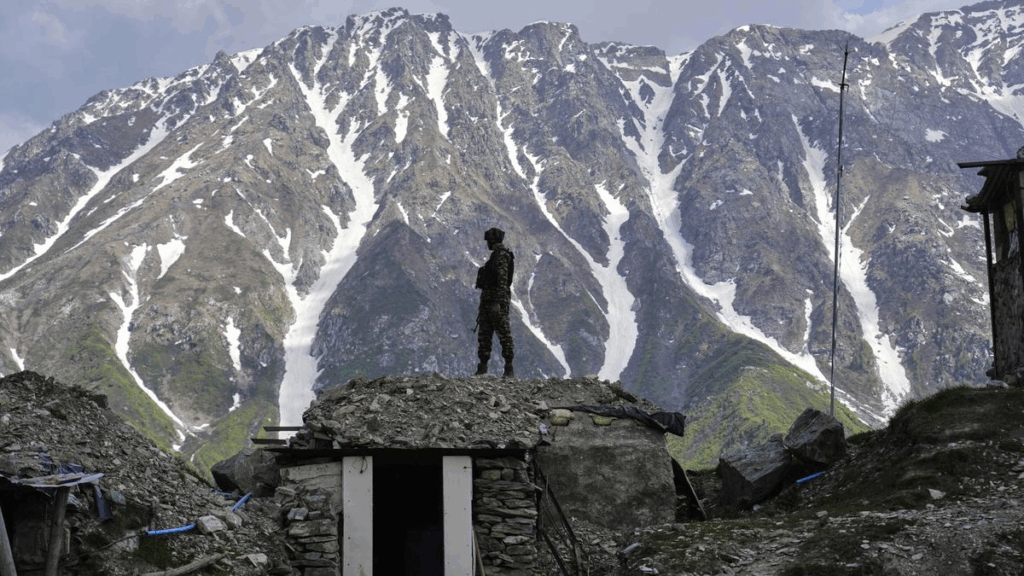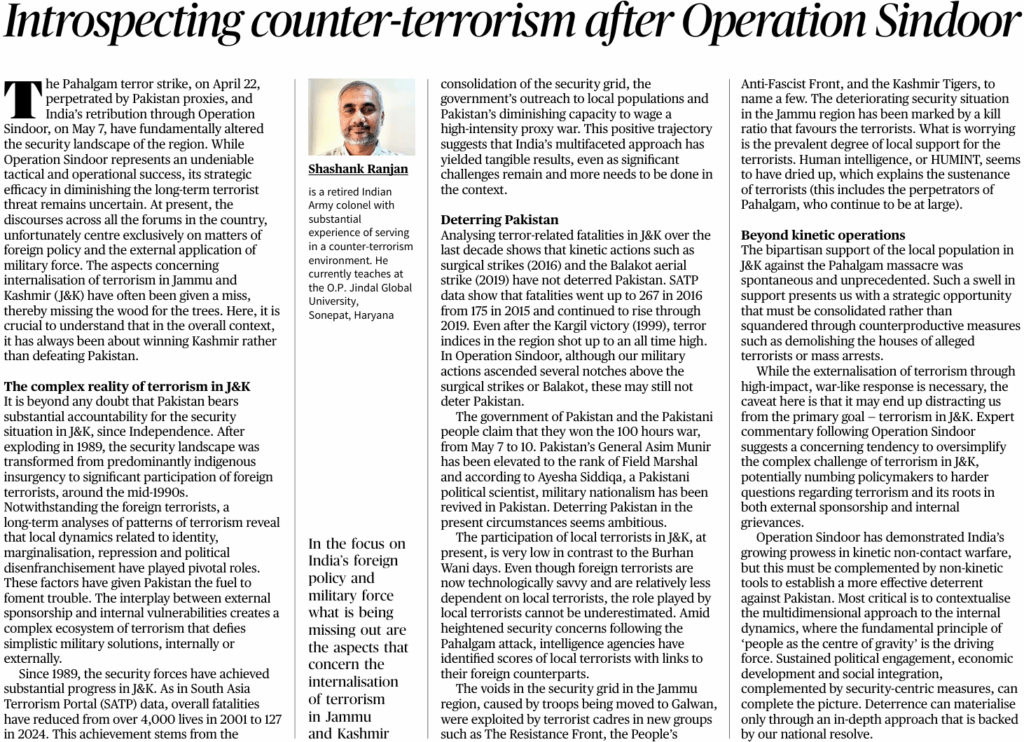Introspecting Counter-Terrorism After Operation Sindoor for GS II Internal Security
INTRODUCTION
After surgery, vermilion, anti-violation” is not just a reflective exercise, is a pressure strategic requirement. In May 2024, an anti-terrorism operation as Operation Sindoor, in the Ravi district of Jammu and Kashmir, marked a significant point of conflict in India’s anti-terrorism story.
Operation Sindoor and the Unfinished War Within: Rethinking Counter-Terrorism in J&K

Why is it in the news?
- On April 22, 2025, the Pahagam terror strike recently took place, followed by India’s anti-retreat operation Sindoor, once again throwing the unstable dynamics of Jammu and Kashmir (J&K) into the national spotlight.
- While Operation Sindoor is in the form of a strategic and operational victory, the long-term strategic value is special in preventing Pakistan-related terrorism in uncertain times.
- Most of the current discourse concerns India’s muscular foreign policy and kinetic military reactions. However, this heavy exterior focus risk is to overcompensate for a more pressure internal reality: deep and constant internalisation of terrorism in Jammu and Kashmir.

- Colonel Shakank Ranjan (retired), as an experienced terrorist expert, observes in a good way, is the real challenge is not only to defeat Pakistan, but to win the trust, trust and cooperation of the Kashmiri people.
- This asks for a fundamental change in strategic thinking-from seeing attention completely through cross-border lenses to accepting and addressing the complex internal ecosystem that maintains it.
- Identification crisis, political isolation and social fragmentation continue to provide a fire that any amount of air strikes or surgical strikes can extinguish on its own.
Background: The Evolving Landscape of Terrorism in J&K
Post-Independence to the 1980s: Seeds of Discontent
- Since 1947, Pakistan has continually sought to destabilise J&K through a mix of propaganda, irregular warfare, and infiltration. However, until the late 1980s, J&K largely experienced sporadic and low-intensity unrest, with insurgency being more political than militant.
1989 Onwards: Rise of Militancy
- In 1989, militancy in J&K exploded, marking the beginning of a prolonged conflict. Initially driven by indigenous sentiments of political marginalisation and identity-related grievances, the movement was gradually hijacked by Pakistan-backed foreign terrorist elements in the mid-1990s.
Groups like Lashkar-e-Taiba (LeT), Jaish-e-Mohammed (JeM), and Hizbul Mujahideen transformed what began as an internal uprising into a full-fledged proxy war.
- Pakistan’s Inter-Services Intelligence (ISI) and its military provided training, arms, and ideological support, using terrorism as an instrument of state policy
Characteristics of contemporary terrorism in J&K
- Hybrid threats and changed strategy: Modern terrorism in Jammu and Kashmir is no longer entirely dependent on foreign-affiliated jihadists.
A new breed of “hybrid terrorists” has emerged, radical and minimally trained through digital media. These people perform short-term attacks before interfering in society. - In addition, new groups such as Resistance Front (TRF) and People’s Anti-Family Front (PAFF) act as an authority for Ghem. They use social media to radical, recruit and promote stories, causing a powerful war of information.
Geographical changes: south to north and now from Jammu
- While Sør-Kashmir was once unrestrained, security operations and local support reductions have forced terrorists to move their hiding places to Nord-Kashmir and Jammu.
- The Poonch-Rajouri belt is now a hotspot, which is aimed at the difficult terrain and the presence of a low squad, due to the redistribution with the Ladakh Post-Galwan.
Strategic sophistication of foreign terrorists
- Foreign terrorists, although in smaller numbers of numbers, are now more technically intelligent, are better trained and work with more autonomy.
- While the recruitment of local cadres has gone down compared to the Burhan Wani era, foreign terrorists appear quickly without relying on local support.
Local support and intelligence deficit
- Despite the strategic benefits, human intelligence is weakened.
- Pahagam strikes criminals remain largely, the indication of local support networks is still active.
- Public silence, logistic help and timely absence of intelligence indicate maintaining sympathy between the blocks of the locals.
Operation Sindoor: Strategic success, strategic questions
- Operation: Between 7 to 10 May 2025, India launched Operation Sindoor, targeting terrorist camps in Pakistan-occupied Kashmir (POK).
- Reports suggest that India’s ability and intentions are marked, using advanced drones, precisely controlled sages and electronic war.
After the operation, sindoor :
- While Indian strategic circles welcomed the operation, Pakistan claimed it as a failed attempt, claiming that “Indian aggression was cancelled.”
- The increase in height and domestic support from General Asim Munir for Field Marshal highlights the revival of military nationalism in Pakistan.
Strategic interval
- Despite its strategic talent, Operation Sindoor cannot stop Pakistan. Previous events strengthen it.
- After the Kargil victory in 1999, the violence increased. Post-Uri (2016) and Balkot (2019) strikes, real deadly growth in later years.
- The SATP data is growing up to 267 in 2015 to 267 in 2016, and remained at a high level continuously until 2019.
Challenge with internalisation of terrorism
- Identification and separation: Many young people in Kashmir struggle with questions about identity, dignity and political agency.
- Their complaints are a fruitful country for Pakistan’s promotion, which portrays them as victims of the state’s oppression.
- It is important to address the perceptions of injustice to prevent bigotry.
Political vacuum: In 2019, Article 370 was cancelled as a water divide. While the integrated J&K is constitutionally, the political transition has left a leadership vacuum. The absence of local, democratic representation makes room for fringe and underground stories.
Development versus democracy: The government has continued the infrastructure and investment initiative in Jammu and Kashmir.
- However, development cannot replace political authority. People need to feel represented, heard and involved in governance.
- After Galwan, Troop relocation has diluted the look in some areas like Jammu. Terrorists have exploited these voids, which are currently working to their advantage. It is necessary to reinforce intelligence protection, Nexus.
The strategic opportunity after Palagam
- Outstanding public condemnation: The spontaneous condemnation of the Pahagam massacre of Kashmiri-SIVIL SOCOM was unique.
- This indicates a possible change in public feeling, away from the support of militants to adaptation to peace and justice.
- From the opportunity to change: Instead of relying on forced reactions such as demolition of houses or mass details, this moment requires strategic sympathy.
- Creative commitment to humans can catalyse permanent changes – accept their grief and ambition.
The way forward:
- Political commitment and democratic integration
- Strengthen fast-track choices and local democratic institutions.
- Attach traditional political parties with ground-level management.
- Make sure political dialogue remains inclusive, non-Pakistani and continuous.
- Intelligence, targeted operationsStrengthen Hamints through trust building and local partnership.
- Improve synergy between technical monitoring and basic intelligence. The address of infiltration of the cross-border with active border handling systems.
- History War, and CountersDistribute against -Propaganda on social media using local languages and affected people. Start social education that emphasises pluralism, democracy and constitutional rights. Family, teachers and religious leaders should be involved in de-redressal programs.
- Legal habilitation and human rights
- Avoid excessive militarisation of civilian places. Make sure that the anti-terrorism act is in strict adherence to constitutional and human rights norms. Review and change laws to prevent abuse while maintaining efficiency.
Conclusions: From revenge to resolution
- Operation Vermilion is an important milestone in India’s anti-terrorism strategy-significantly reflecting the right talent, accurate war capacity and political will. Still, as it shows history and data, such kinetic reactions, even though they are essential, are inadequate as standalone strategies.
- The firmness of terrorism in Jammu and Kashmir, despite many military victories – from Kargil to Balakot and now Sindoor – a deep, structural reality: terrorism is not only imported in the region; It is internal.
- The developed nature of extremism, characterised by hybrid terrorists, moves geographical and sophisticated foreign managers, making the challenge more complicated than ever.
- But the real battlefield lies in the heads and hearts of the Kashmiri people. Internalisation of terrorism feeds the perception of a political vacuum, identity crisis and exclusion. Without addressing these causes, the external detention risk is reduced in the case of a temporary disruption.
MAINS PRACTICE QUESTION
Question. “Operation Sindoor has highlighted India’s growing military capabilities, but the real challenge lies in addressing the internalisation of terrorism in Jammu and Kashmir.” Critically examine this statement in light of recent developments. Suggest a comprehensive strategy for effective counter-terrorism that balances kinetic and non-kinetic approaches.
PRACTICE QUESTION
Q. Which of the following statements best captures the strategic paradox of India’s counter-terrorism approach in Jammu and Kashmir post-Operation Sindoor?
A. Despite successful kinetic strikes, India’s counter-terrorism gains remain limited due to superior Pakistani military capabilities and technological edge.
B. India’s counter-terrorism strategy has effectively neutralised all forms of terrorism, including both foreign and hybrid threats, due to advanced military operations.
C. High-impact military responses like Operation Sindoor generate short-term tactical advantages, but fail to sustainably deter terrorism in J&K due to unresolved internal socio-political grievances.
D. Political integration and economic development have completely mitigated local terrorist recruitment, rendering foreign-sponsored terrorism the sole challenge in Kashmir.
Answer: C
Explanation:
Option C best encapsulates the nuanced paradox: while operations like Sindoor demonstrate tactical and technological strength, their long-term impact is diluted by persistent internal factors, identity issues, political alienation, and the internalisation of terrorism.







